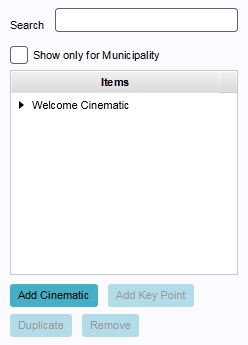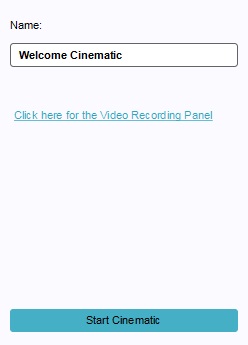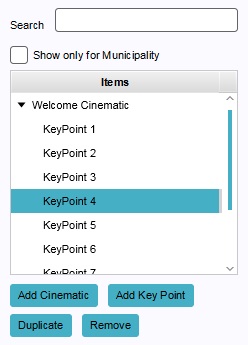Cinematic: Difference between revisions
mNo edit summary |
|||
| Line 17: | Line 17: | ||
==Creating and editing cinematics== | ==Creating and editing cinematics== | ||
{{editor ribbon|header=Animations|bar=Cinematics}} | {{editor ribbon|header=Animations|bar=Cinematics}} | ||
In the editor, it is possible to create, duplicate, edit and delete cinematics in a project. It is also possible to create | In the editor, it is possible to create, duplicate, edit and delete cinematics in a project. It is also possible to create keypoints, or remove keypoints from a cinematic. | ||
===Creating or removing cinematics=== | ===Creating or removing cinematics=== | ||
| Line 41: | Line 41: | ||
: ''This button starts the selected cinematic for the user that presses it. This is useful to test the cinematic. Note that this also starts a [[test run]]. This is not an editable property.''<br clear=right> | : ''This button starts the selected cinematic for the user that presses it. This is useful to test the cinematic. Note that this also starts a [[test run]]. This is not an editable property.''<br clear=right> | ||
====Editing | ====Editing KeyPoints==== | ||
{{editor ribbon|header=Animations|bar=Cinematics|left panel=Any cinematic}} | {{editor ribbon|header=Animations|bar=Cinematics|left panel=Any cinematic}} | ||
The most important property of a cinematic is the | The most important property of a cinematic is the keypoints. These determine the path that the cinematic takes. A cinematic should have at least 1 keypoint. | ||
=====Creating and removing | =====Creating and removing keypoints===== | ||
[[File:Cinematics-keypoint-left.jpg|frame|left|The left panel also allows you to select | [[File:Cinematics-keypoint-left.jpg|frame|left|The left panel also allows you to select keypoints of cinematics.]] | ||
{{Editor steps|title=add a new keypoint|Select "Animations" in the ribbon header.|Select "Cinematics" in the ribbon bar.|Select the cinematic you want to add the keypoint to in the [[editor#Left_Panel|left panel]].|If there is already at least one keypoint present, select the keypoint you want the new keypoint to be added after.|Select "Add | {{Editor steps|title=add a new keypoint|Select "Animations" in the ribbon header.|Select "Cinematics" in the ribbon bar.|Select the cinematic you want to add the keypoint to in the [[editor#Left_Panel|left panel]].|If there is already at least one keypoint present, select the keypoint you want the new keypoint to be added after.|Select "Add KeyPoint".}} | ||
{{Editor steps|title=remove an existing | {{Editor steps|title=remove an existing keypoint|Select "Animations" in the ribbon header.|Select "Cinematics" in the ribbon bar.|Select the cinematic from which you wish to remove a keypoint.|Select the keypoint you wish to remove.|Select "Remove".}} | ||
Revision as of 13:07, 13 August 2015
Cinematic
Cinematic refers to something which relates to, or is itself, an animation or movie. Something which is cinematic is generally non-interactive.
How do cinematics relate to the Tygron Engine
In the Tygron Engine, a cinematic is an animation through the 3D world. During a cinematic, the user is no longer in control of their camera. Instead, the camera moves automatically between key locations. The user is also unable to take any actions, until the cinematic is ended. When the cinematic ends, the camera is places back into a normal position, directed at the last key location's camera direction.
The cinematic also displays text to the user when necessary. This can happen in two ways. The text can be displayed as a subtitle, while the camera continues to move in the cinematic. Alternatively, displaying the text can pause the cinematic, until the user confirms they wish to continue.
When to use cinematics
Cinematics are generally used for exposition to the user. When it is necessary to provide information to a user, or to direct their attention to a specific predefined location in the 3D world, this can be done using a cinematic. Because a cinematic takes away the user's ability to move the camera themselves, and to take actions, a cinematic is best used for vital information which only has to be provided once. An example of this is an introduction to the area at the start of the session.
Coupling cinematics to stakeholders
While editing, it is possible to attach a cinematic to a stakeholder for a specific level. This means that when the level starts, the user in the role of that stakeholder will see the provided cinematic.
Creating and editing cinematics
Template:Editor ribbon In the editor, it is possible to create, duplicate, edit and delete cinematics in a project. It is also possible to create keypoints, or remove keypoints from a cinematic.
Creating or removing cinematics
- Select "Animations" in the ribbon header.
- Select "Cinematics" in the ribbon bar.
- Select "Add cinematic" in the left panel.
- Select "Animations" in the ribbon header.
- Select "Cinematics" in the ribbon bar.
- Select the existing cinematic you wish to duplicate.
- Select "Duplicate" in the left panel.
- Select "Animations" in the ribbon header.
- Select "Cinematics" in the ribbon bar.
- Select the cinematic you wish to remove.
- Select "Remove" in the left panel.
Editing cinematics
There is only one property directly related to cinematics, but the right panel offers access to several other functions as well. Cinematics also contain keypoints, which define the path the cinematic takes through the 3D world.
Name
- The name of the cinematic. This is also the name that will appear in the text panel if the cinematic pauses while displaying texts. Otherwise, the name only assists in differentiating between cinematics when selecting them in the editor. You can change this by altering the text in the text field.
Video recording
- A link to the video recording panel. Cinematics and video recording can be used in conjunction with each other. This is not an editable property.
Start cinematic
- This button starts the selected cinematic for the user that presses it. This is useful to test the cinematic. Note that this also starts a test run. This is not an editable property.
Editing KeyPoints
Template:Editor ribbon The most important property of a cinematic is the keypoints. These determine the path that the cinematic takes. A cinematic should have at least 1 keypoint.
Creating and removing keypoints
- Select "Animations" in the ribbon header.
- Select "Cinematics" in the ribbon bar.
- Select the cinematic you want to add the keypoint to in the left panel.
- If there is already at least one keypoint present, select the keypoint you want the new keypoint to be added after.
- Select "Add KeyPoint".
- Select "Animations" in the ribbon header.
- Select "Cinematics" in the ribbon bar.
- Select the cinematic from which you wish to remove a keypoint.
- Select the keypoint you wish to remove.
- Select "Remove".



